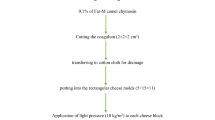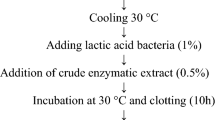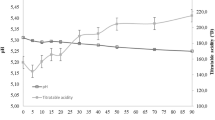Abstract
In this study, the effect of pasteurization and use of starter cultures on physicochemical, microbiological and functional properties of a traditional Iranian semi-hard cheese (Lighvan cheese) was evaluated during stages of ripening (1, 60, 120 days). Profiles of polar metabolites were analyzed by gas-chromatography mass-spectrometry (GC–MS). Considerable free amino acids such as gamma-aminobutyric acid (GABA) were found in samples that have higher microbial communities i.e. raw sheep's milk without use of starter cultures and pasteurized sheep's milk cheese with co-culture. However, GABA was not found in pasteurized sheep's milk cheese without starter culture during ripening. Conclusively, the application of the starter culture could reduce the ripening time of sheep's milk cheese and could be an appropriate approach to increase the functionality of the sheep's milk cheese.
Similar content being viewed by others
References
Abel MS, McCandless DW (1999) Elevated γ-aminobutyric acid levels attenuate the metabolic response to bilateral ischemia. J Neurochem 58(2):740–744
Adeghate E, Ponery AS (2002) GABA in the endocrine pancreas: cellular localization and function in normal and diabetic rats. Tissue Cell 34(1):1–6
Agostini C, Eckert C, Vincenzi A, Machado BL, Jordon BC, Kipper JP, Dullius A, Dullius CH, Lehn DN, Sperotto RA, Pozzobon A, Granada CE, Maciel MJ, Volken de Souza CF (2018) Characterization of technological and probiotic properties of indigenous Lactobacillus spp. from South Brazil. 3 Biotech 8(11):451
Atasoy F, Atilla Y, Huseyin T, Barbaros O (2008) Effects of heat treatment and starter culture on the properties of traditional Urfa cheeses (a white-brined Turkish cheese) produced from bovine milk. Food Control 19:278–285
Azarnia S, Robert N, Lee B (2006) Biotechnological methods to accelerate cheddar cheese ripening. Crit Rev Biotechnol 26:121–143
Balthazar CF, Pimentel TC, Ferrão LL, Almada CN, Santillo A, Albenzio M, Mollakhalili N, Mortazavian AM, Nascimento JS, Silva MC, Freitas MQ et al (2017) Sheep milk: physicochemical characteristics and relevance for functional food development. Compr Rev Food Sci Food Saf 16(2):247–262
Barrett E, Ross RP, O’Toole PW, Fitzgerald GF, Stanton C (2012) γ- Aminobutyric acid production by culturable bacteria from the human intestine. J Appl Microbiol 113:411–417
Battaglioli G, Liu H, Martin DL (2003) Kinetic differences between the isoforms of glutamate decarboxylase: implications for the regulation of GABA synthesis. J Neurochem 86(4):879–887
Cotter PD, Hill C (2003) Surviving the acid test: responses of gram-positive bacteria to low pH. Microbiol Mol Biol Rev 67:429–453
Diana M, Quílez J, Rafecas M (2014a) Gamma-aminobutyric acid as a bioactive compound in foods: a review. J Funct Foods 10:407–420
Diana M, Rafecas M, Arco C, Quílez J (2014b) Free amino acid profile of Spanish artisanal cheeses: importance of gamma-aminobutyric acid (GABA) and ornithine content. J Food Compos Anal 35(2):94–100
Edalatian E, Habibi-Najafi M, Mortazavi A, Mayo B (2012) The biodiversity and evolution of lactic flora during ripening of the Iranian semisoft Lighvan cheese. Int J Dairy Technol 65:81–89
Fernández D, Arenas R, Tornadijo ME, Ferrazza RE, Fresno JM (2012) Zamorano cheese. In: Hui YH, Evranuz ÖE (eds) Handbook of animal-based fermented food and beverage technology. CRC Press, Boca Ratón, Florida, pp 451–472
Fox PE, McSweeney PLH, Lynch CM (1998) Significance of non-starter lactic acid bacteria in Cheddar cheese. Aust J Dairy Technol 53:83–89
Fox PF, Guinee TP, Cogan TM, McSweeney PLH (2016) Biochemistry of cheese ripening. Fundamentals of cheese science. Springer, New York, pp 391–443
Giraffa G (2003) Functionality of Enterococci in dairy products. Int J Food Microbiol 88:215–222
González L, Cuadrillero A, Castro JM, Bernardo A, Tornadijo ME (2015) Selection of lactic acid bacteria isolated from San Simón da Costa Cheese (PDO) in order to develop an autochthonous starter culture. Adv Microbiol 5:748–759
Guinee TP (2004) Salting and the role of salt in cheese. Int J Dairy Technol 57:99–109
Hejtmánkov A, Pivec V, Trnkov E, Dragounov H (2012) Differences in the composition of total and whey proteins in goat and ewe's milk and their changes throughout the lactation period. Czech J Anim Sci 57:323–331
Herreros MA, Fresno JM, González-Prieto MJ, Tornadijo ME (2003) Technological characterization of lactic acid bacteria isolated from Armada cheese (a Spanish goats’ milk cheese). Int Dairy J 13:469–479
Ito K, Tanaka K, Nishibe Y, Hasegawa J, Ueno H (2007) GABA-synthesizing enzyme, GAD67, from dermal fibroblasts: evidence for a new skin function. Biochim Biophys Acta 1770(2):291–296
Lacroix N, St-Gelais D, Champagne CP, Vuillemard JC (2013) Gamma- aminobutyric acid-producing abilities of lactococcal strains isolated from old-style cheese starters. Dairy Sci Technol 93:315–327
Madrau MA, Mangia NP, Murgia MA, Sanna MG, Garau G, Leccis L, Caredda M, Deiana P (2006) Employment of autochthonous microflora in Pecorino Sardo cheese manufacturing and evolution of physicochemical parameters during ripening. Int Dairy J 16:876–885
Manca G, Porcu A, Ru A, Salaris M, Franco MA, De Santis EPL (2015) Comparison of γ-aminobutyric acid and biogenic amine content of different types of ewe’s milk cheese produced in Sardinia. Italy Ital J Food Saf 4:4700
Mangia NP, Murgia MA, Garau G, Sanna MG, Deiana P (2008) Influence of selected lab cultures on the evolution of free amino acids, free fatty acids and Fiore Sardo cheese microflora during the ripening. Food Microbiol 25:366–377
Masoud W, Vogensen FK, Lillevang S, Abu Al-Soud W, Sørensen SJ, Jakobsen M (2012) The fate of indigenous microbiota, starter cultures, Escherichia coli, Listeria innocua and Staphylococcus aureus in Danish raw milk and cheeses determined by pyrosequencing and quantitative real time (qRT)-PCR. Int J Food Microbiol 153:192–202
Minervini F, Bilancia MT, Siragusa S, Gobbetti M, Caponio F (2009) Fermented Goats milk produced with selected multiple starters as a potentially functional food. Food Microbiol 26:559–564
Mirzaei H (2011) Microbiological changes in Lighvan cheese throughout its manufacture and ripening. Afr J Microbiol Res 5(13):1609–1614
Morales M, Lobato C, Álvarez J, Vernon E (2012) Effect of milk pasteurization and acidification method on the chemical composition and microstructure of a mexican pasta filata cheese. Food Sci Technol 45:132–141
Piras C, Cesare Marincola F, Savorani F, Engelsen SB, Cosentino S, Viale S, Pisano MB (2013) A NMR metabolomics study of the ripening process of the Fiore Sardo cheese produced with autochthonous adjunct cultures. Food Chem 141:2137–2147
Pisano MB, Scano P, Murgia A, Cosentino S, Caboni P (2016) Metabolomics and microbiological profile of Italian mozzarella cheese produced with buffalo and cow milk. Food Chem 192:618–624
Pouliot-Mathieu K, Gardner-Fortier C, Lemieux S, St-Gelais D, Champagne CP, Vuillemard JC (2013) Effect of cheese containing gamma-aminobutyric acid- producing lactic acid bacteria on blood pressure in men. Pharm Nutr 1:141–148
Poveda JM, Cabezas L, McSweeney PLH (2004) Free amino acid content of Manchego cheese manufactured with different starter cultures and changes throughout ripening. Food Chem 84:213–218
Poveda JM, Chicón R, Cabezas L (2015) Biogenic amine content and proteolysis in Manchego cheese manufactured with Lactobacillus paracasei subsp. paracasei as adjunct and other autochthonous strains as starters. Int Dairy J 47:94–101
Poveda JM, Molina GM, Gómez-Alonso S (2016) Variability of biogenic amine and free amino acid concentrations in regionally produced goat milk cheeses. J Food Compos Anal 51:85–92
Renes E, Ladero ME, Tornadijo J, Fresno M (2019) Production of sheep milk cheese with high γ-aminobutyric acid and ornithine concentration and with reduced biogenic amines level using autochthonous lactic acid bacteria strains. Food Microbiol 78:1–10
Settanni L, Moschetti G (2010) Non-starter lactic acid bacteria used to improve cheese quality and provide health benefits. Food Microbiol 7:691–697
Rehman SU, Banks JM, McSweeney PLH, Fox PF (2000) Effect of ripening temperature on the growth and significance of non-starter lactic acid bacteria in Cheddar cheese made from raw or pasteurized milk. Int Dairy J 10(1–2):45–53
Siragusa S, De Angelis M, Di Cagno R, Rizzello CG, Coda R, Gobbetti M (2007) Synthesis of gamma-aminobutyric acid by lactic acid bacteria isolated from a variety of Italian cheeses. Appl Environ Microbiol 73:7283–7290
Sugino T, Shirai T, Kajimoto Y, Kajimoto O (2008) l-Ornithine supplementation attenuates physical fatigue in healthy volunteers by modulating lipid and amino acid metabolism. Nutr Res 28:738–743
Sun BS (2004) Research of some physiological active substance by fermentation of Monascus Spp. (Dissertation for Master Degree). Zhejiang Industry University, China, p 40–55
Tabet E, Mangia N, Mouannes E, Hassoun G, Helal Z, Deiana P (2016) Characterization of goat milk from Lebanese Baladi breed and hissuitability for setting up a ripened cheese using a selected starterculture. Small Rumin Res 140:13–17
Wong CG, Bottiglieri T, Snead OC (2003) GABA, gamma-hydroxybutyric acid, and neurological disease. Ann Neurol 54(6):3–12
Xie Z, Xia S, Le GW (2014) Gamma-aminobutyric acid improves oxidative stress and function of the thyroid in high-fat diet fed mice. J Funct Foods 8:76–86
Yoon Y, Lee S, Choi KH (2016) Review: microbial benefits and risks of raw milk cheese. Food Control 63:201–215
Acknowledgements
The authors are grateful to the Department of Food Science and Technology in Isfahan University of Technology (Isfahan, Iran) and Department of Medicinal chemistry in Shaheed Beheshti University of Medical sciences (Tehran, Iran) for financial support of the project.
Author information
Authors and Affiliations
Contributions
Conceived the study: VS. Wrote the manuscript: VS, MSZ. Prepared tables: VS. Prepared illustrations: VS. Analyzed the data obtained by GC-MSS: FK. Edit and comment on the manuscript: MSZ, FK, SSZ.
Corresponding author
Ethics declarations
Conflict of interest
The authors declare that they have no conflict of interest in the publication.
Ethical approval
Our research did not include any human subjects and animal experiments.
Additional information
Accession Numbers: The authors declare that no Molecular sequencing have been conducted in this article.
Rights and permissions
About this article
Cite this article
Saidi, V., Sheikh-Zeinoddin, M., Kobarfard, F. et al. Bioactive characteristics of a semi-hard non-starter culture cheese made from raw or pasteurized sheep's milk. 3 Biotech 10, 85 (2020). https://doi.org/10.1007/s13205-020-2075-z
Received:
Accepted:
Published:
DOI: https://doi.org/10.1007/s13205-020-2075-z




